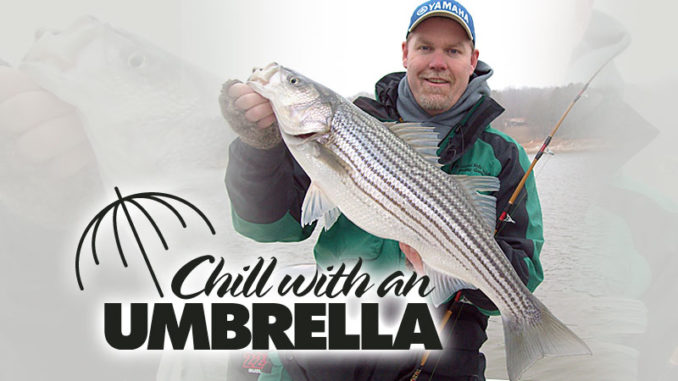
Try umbrella rigs in cold-weather tactic for striped bass
Many anglers target striped bass across most of the Southeast. And for them, the name Mack Farr is synonymous with umbrella rig fishing.
Farr, a guide on Georgia’s Lake Lanier, has been fishing professionally for more than 30 years. And he has taken the concept of trolling umbrella rigs — originally a saltwater-fishing tactic — and adapted it to fishing for stripers in landlocked, freshwater reservoirs.
According to Farr, umbrella-rig fishing is best on just about any lake that has a sizeable population of stripers when water temperatures drop to the low- to mid-50s. At that point, he said, the fish become dormant and won’t chase live bait. In fact, Farr has compared the two, side by side under winter conditions.
“It’s an impulse bite,” Farr said. “The fish are in a neutral or even negative mood. And this big screaming rig comes through, and their first instinct is to kill it.”
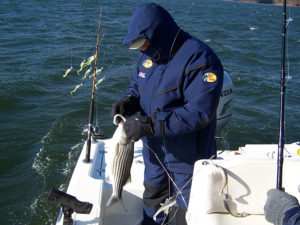
Farr also said umbrella rigs are an excellent catch-and-release tactic. Stripers are typically hooked inside the mouth or somewhere on the outside of the jaw. Combine that with cold water, and even the biggest fish can swim away unharmed after release.
Another bonus is that “U-rigs” — as they’re often referred to — have multiple baits rather than a single hook. It’s not uncommon to spur the competitiveness of other stripers in the school when a striper comes ripping by with other baits hanging out of its mouth. Reeling in two, three or even four striped bass on one rod is not a feat for the light-hearted.
Trolling slow is the key
Pulling an umbrella rig is more commonly done with the use of the outboard motor on whatever boat you’re using. But some anglers prefer to use a 24- or 36-volt trolling motor to keep from spooking schools of stripers feeding near the surface.
“I can teach anyone to pull umbrella rigs off of any type of boat so long as the boat will idle down to or maintain steady speeds at 2 or 3 miles per hour” Farr said.
Farr puts the rigs out on stout baitcasting tackle with line in the 50-pound class. He runs two rigs, one on each side of the boat and cautions anglers when deploying rigs.
“Only let the rig out 20 to 30 feet at a time,” he said. “Leaving the reel in free spool will send it to the bottom, where it will hang up. I keep my thumb on the spool as it goes out and then flip the level (wind) and pull the rig back up every so often until I have the desired amount of line out.”
Space the rigs apart to keep them from fouling
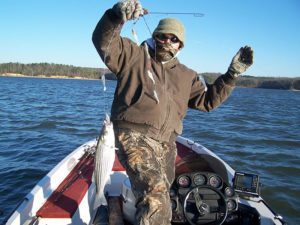
Farr typically runs rigs out between 60 and 150 feet behind the boat, depending on the water depth, the weight of the rig and the speed of the boat. He manufactures umbrella rigs. The packaging on his products carry a chart that’s a good starting point for learning how far back to put the rigs to reach the desired depth.
“I always space the rigs at least 30 feet apart so they don’t hang if the lines cross,” Farr said. “And it’s wise to put the heavier of two rigs further back so it will run deeper and under the other during a turn.”
With two rigs deployed, Farr will maintain his boat speed between 2.5 mph and 3.0 mph as measured on his sonar/GPS unit. A constant speed is not desired, and rpm changes in the motor will cause the rigs to veer and flair like a real pod of baitfish. The trick is knowing when to zig and when to zag.
Keep an eye on your electronics
“I’m constantly watching my sonar” he said. “I want to know what’s under the boat so I’ll know whether to speed up to clear the top of a hump or brush pile and when to slow down or even pop the boat in idle, which makes the rigs drop and flutter. This is a great tactic when pulling through a suspended school of fish. Drop that rig right on their heads and then put it back in gear, and the rig comes back up, usually with a fish in tow.”
One of the chief complaints Farr hears about using umbrella rigs is that rigs are so heavy, it’s not like really fighting a fish with close to 2 pounds in jigs and metal on the line.
“That’s why I take the boat out of gear when a fish is on” he said. “Let the angler fight the fish, not the fish and the boat, and it’s really a good fight.”
Farr admits that the exception to this is when there’s obviously a big fish on the rod that’s real close to standing timber. Then, he’ll use the boat to help get the fish into the clear, then pull it out of gear.
Lighten up with Mini-Macks
Having made and sold umbrella rigs primarily for striped bass fishing, Mack Farr watched the rise and crest of umbrella-rig fishing for black bass with interest. He acknowledged the utility of a lighter weight U-rig that could either be cast to schooling fish or slow-trolled under more controlled conditions. His concept was the Mini-Mack.
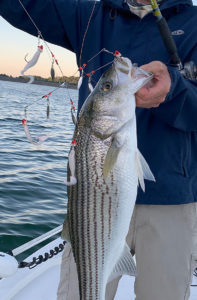
“When we designed the Mini-Mack, it was for casting to striped bass. It’s a lot sturdier than some of the more-recent rigs that have become popular with black bass anglers,” he said. “I actually realized how well it would work for slow-trolling by mistake.”
While filming a television show, Farr (www.captmacks.com) set the rod in a rod-holder while the film crew was moving down the bank to another casting spot. The rod bent over with a nice-sized striper.
Mini-Macks are lighter, easier to fish
“That set off a light bulb, and when I got home, I started experimenting with trolling these rigs instead of casting,” he said.
The first plus is lighter weight. An entire Mini-Mack weighs slightly more than 2 ounces. Accordingly, it can be fished using conventional striped bass tackle, 20-pound class tackle vs. the 50-pound class. With lighter weight and lighter tackle, the rig can be fished slower.
“The big rigs work on reaction. But this is more finesse, if you can say that about a rig that has five hooks on it,” Farr said. “It does lend itself better to contour fishing and getting closer to fish holding structure.”
The other added feature is the ability to slow-troll a Mini-Mack behind a planer board. This begs a comparison between the effectiveness of rigs versus live bait.
“I’ve put them head to head,” Farr said. “Don’t get me wrong; I’m still a big believer in bait. I’m going to have live bait with me on just about every trip I take. But I’ve had slow days when I’m free-lining six live-bait rods with little success. And I swapped one out for a Mini-Mack rig and started catching fish.”



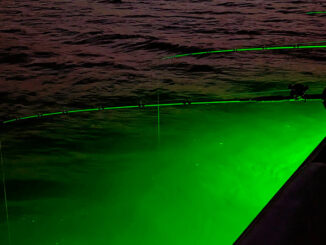

Link is wrong for Captain Mack Farr. Here is the correct link. http://www.captmacks.com/
Thanks for the correction!